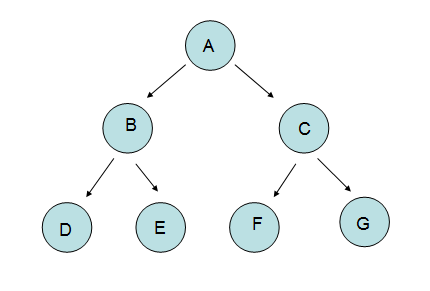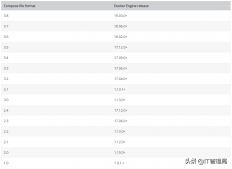先前我们讲的都是“线性结构”,他的特征就是“一个节点最多有一个”前驱“和一个”后继“。那么我们今天讲的树会是怎样的呢?
我们可以对”线性结构“改造一下,变为”一个节点最多有一个"前驱“和”多个后继“。哈哈,这就是我们今天说的”树“。
一: 树
我们思维中的”树“就是一种枝繁叶茂的形象,那么数据结构中的”树“该是怎么样呢?对的,他是一种现实中倒立的树。

1:术语
其实树中有很多术语的,这个是我们学习树形结构必须掌握的。
<1> 父节点,子节点,兄弟节点
这个就比较简单了,b和c的父节点就是a,反过来说就是b和c是a的子节点。b和c就是兄弟节点。
<2> 结点的度
其实”度“就是”分支数“,比如a的分支数有两个“b和c",那么a的度为2。
<3> 树的度
看似比较莫名其妙吧,他和”结点的度“的区别就是,树的度讲究大局观,乃树中最大的结点度,其实也就是2。
<4> 叶结点,分支结点
叶结点就是既没有左孩子也没有右孩子结点,也就是结点度为0。分支节点也就是if的else的条件咯。
<5> 结点的层数
这个很简单,也就是树有几层。
<6> 有序树,无序树
有序树我们先前也用过,比如“堆”和“二叉排序树”,说明这种树是按照一定的规则进行排序的,else条件就是无序树。
<7> 森林
现实中,很多的树形成了森林,那在数据结构中,我们把上图的“a”节点砍掉,那么b,c子树合一起就是森林咯。
2: 树的表示
树这个结构的表示其实有很多种,常用的也就是“括号”表示法。
比如上面的树就可以表示为:(a(b(d),(e)),(c(f),(g)))
二: 二叉树
在我们项目开发中,很多地方都会用到树,但是多叉树的处理还是比较纠结的,所以俺们本着“大事化小,小事化了“的原则
把”多叉树“转化为”二叉树“,那么问题就简化了很多。
1: ”二叉树“和”树“有什么差异呢?
第一点: 树的度没有限制,而“二叉树”最多只能有两个,不然也就不叫二叉树了,哈哈。
第二点:树中的子树没有左右划分,很简单啊,找不到参照点,二叉树就有参照物咯。
2: 二叉树的类型
二叉树中有两种比较完美的类型,“完全二叉树”和“满二叉树”。
<1> 满二叉树
除叶子节点外,所有节点的度都为2,文章开头处的树就是这里的“满二叉树”。
<2> 完全二叉树
必须要满足两个条件就即可: 干掉最后一层,二叉树变为“满二叉树”。
最后一层的叶节点必须是“从左到右”依次排开。
我们干掉文章开头处的节点“f和”g",此时还是“完全二叉树”,但已经不是“满二叉树”了,你懂的。
3: 二叉树的性质
二叉树中有5点性质非常重要,也是俺们必须要记住的。
<1> 二叉树中,第i层的节点最多有2(i-1)个。
<2> 深度为k的二叉树最多有2k-1个节点。
<3> 二叉树中,叶子节点树为n1个,度为2的节点有n2个,那么n1=n2+1。
<4> 具有n个结点的二叉树深度为(log2 n)+1层。
<5> n个结点的完全二叉树如何用顺序存储,对于其中的一个结点i,存在以下关系,
2*i是结点i的父结点。
i/2是结点i的左孩子。
(i/2)+1是结点i的右孩子。
4: 二叉树的顺序存储
同样的存储方式也有两种,“顺序存储”和“链式存储”。
<1> 顺序存储
说实话,树的存储用顺序结构比较少,因为从性质定理中我们都可以看出只限定为“完全二叉树”,那么如果二叉树不是
“完全二叉树”,那我们就麻烦了,必须将其转化为“完全二叉树”,将空的节点可以用“#”代替,图中也可看出,为了维护
性质定理5的要求,我们牺牲了两个”资源“的空间。

<2> 链式存储
上面也说了,顺序存储会造成资源的浪费,所以嘛,我们开发中用的比较多的还是“链式存储”,同样“链式存储”
也非常的形象,非常的合理。
一个结点存放着一个“左指针”和一个“右指针”,这就是二叉链表。
如何方便的查找到该结点的父结点,可以采用三叉链表。
5: 常用操作
一般也就是“添加结点“,“查找节点”,“计算深度”,“遍历结点”,“清空结点”
<1> 这里我们就用二叉链表来定义链式存储模型
复制代码 代码如下:
#region 二叉链表存储结构
/// <summary>
/// 二叉链表存储结构
/// </summary>
/// <typeparam name="t"></typeparam>
public class chaintree<t>
{
public t data;
public chaintree<t> left;
public chaintree<t> right;
}
#endregion
<2> 添加结点
要添加结点,我们就要找到添加结点的父结点,并且根据指示插入到父结点中指定左结点或者右结点。
复制代码 代码如下:
#region 将指定节点插入到二叉树中
/// <summary>
/// 将指定节点插入到二叉树中
/// </summary>
/// <typeparam name="t"></typeparam>
/// <param name="tree"></param>
/// <param name="node"></param>
/// <param name="direction">插入做左是右</param>
/// <returns></returns>
public chaintree<t> bintreeaddnode<t>(chaintree<t> tree, chaintree<t> node, t data, direction direction)
{
if (tree == null)
return null;
if (tree.data.equals(data))
{
switch (direction)
{
case direction.left:
if (tree.left != null)
throw new exception("树的左节点不为空,不能插入");
else
tree.left = node;
break;
case direction.right:
if (tree.right != null)
throw new exception("树的右节点不为空,不能插入");
else
tree.right = node;
break;
}
}
bintreeaddnode(tree.left, node, data, direction);
bintreeaddnode(tree.right, node, data, direction);
return tree;
}
#endregion
<3> 查找节点
二叉树中到处都散发着递归思想,很能锻炼一下我们对递归的认识,同样查找也是用到了递归思想。
复制代码 代码如下:
#region 在二叉树中查找指定的key
/// <summary>
///在二叉树中查找指定的key
/// </summary>
/// <typeparam name="t"></typeparam>
/// <param name="tree"></param>
/// <param name="data"></param>
/// <returns></returns>
public chaintree<t> bintreefind<t>(chaintree<t> tree, t data)
{
if (tree == null)
return null;
if (tree.data.equals(data))
return tree;
return bintreefind(tree, data);
}
#endregion
<4> 计算深度
这个问题纠结了我二个多小时,原因在于没有深刻的体会到递归,其实主要思想就是递归左子树和右子树,然后得出较大的一个。
复制代码 代码如下:
#region 获取二叉树的深度
/// <summary>
/// 获取二叉树的深度
/// </summary>
/// <typeparam name="t"></typeparam>
/// <param name="tree"></param>
/// <returns></returns>
public int bintreelen<t>(chaintree<t> tree)
{
int leftlength;
int rightlength;
if (tree == null)
return 0;
//递归左子树的深度
leftlength = bintreelen(tree.left);
//递归右子书的深度
rightlength = bintreelen(tree.right);
if (leftlength > rightlength)
return leftlength + 1;
else
return rightlength + 1;
}
#endregion
<5> 遍历结点
二叉树中遍历节点的方法还是比较多的,有“先序”,“中序”,“后序”,“按层”,其实这些东西只可意会,不可言传,真的很难在口头
上说清楚,需要反复的体会递归思想。
先序:先访问根,然后递归访问左子树,最后递归右子树。(dlr模式)
中序:先递归访问左子树,在访问根,最后递归右子树。(ldr模式)
后序:先递归访问左子树,然后递归访问右子树,最后访问根。(lrd模式)
按层:这个比较简单,从上到下,从左到右的遍历节点。
复制代码 代码如下:
#region 二叉树的先序遍历
/// <summary>
/// 二叉树的先序遍历
/// </summary>
/// <typeparam name="t"></typeparam>
/// <param name="tree"></param>
public void bintree_dlr<t>(chaintree<t> tree)
{
if (tree == null)
return;
//先输出根元素
console.write(tree.data + "\t");
//然后遍历左子树
bintree_dlr(tree.left);
//最后遍历右子树
bintree_dlr(tree.right);
}
#endregion
#region 二叉树的中序遍历
/// <summary>
/// 二叉树的中序遍历
/// </summary>
/// <typeparam name="t"></typeparam>
/// <param name="tree"></param>
public void bintree_ldr<t>(chaintree<t> tree)
{
if (tree == null)
return;
//优先遍历左子树
bintree_ldr(tree.left);
//然后输出节点
console.write(tree.data + "\t");
//最后遍历右子树
bintree_ldr(tree.right);
}
#endregion
#region 二叉树的后序遍历
/// <summary>
/// 二叉树的后序遍历
/// </summary>
/// <typeparam name="t"></typeparam>
/// <param name="tree"></param>
public void bintree_lrd<t>(chaintree<t> tree)
{
if (tree == null)
return;
//优先遍历左子树
bintree_lrd(tree.left);
//然后遍历右子树
bintree_lrd(tree.right);
//最后输出节点元素
console.write(tree.data + "\t");
}
#endregion
#region 二叉树的按层遍历
/// <summary>
/// 二叉树的按层遍历
/// </summary>
/// <typeparam name="t"></typeparam>
/// <param name="tree"></param>
public void bintree_level<t>(chaintree<t> tree)
{
if (tree == null)
return;
//申请保存空间
chaintree<t>[] treelist = new chaintree<t>[length];
int head = 0;
int tail = 0;
//存放数组
treelist[tail] = tree;
//循环链中计算tail位置
tail = (tail + 1) % length;
while (head != tail)
{
var tempnode = treelist[head];
head = (head + 1) % length;
//输出节点
console.write(tempnode.data + "\t");
//如果左子树不为空,则将左子树存于数组的tail位置
if (tempnode.left != null)
{
treelist[tail] = tempnode.left;
tail = (tail + 1) % length;
}
//如果右子树不为空,则将右子树存于数组的tail位置
if (tempnode.right != null)
{
treelist[tail] = tempnode.right;
tail = (tail + 1) % length;
}
}
}
#endregion
<6> 清空二叉树
虽然c#里面有gc,但是我们能自己释放的就不麻烦gc了,同样清空二叉树节点,我们用到了递归,说实话,这次练习让我喜欢
上的递归,虽然xxx的情况下,递归的不是很好,但是递归还是很强大的。
复制代码 代码如下:
#region 清空二叉树
/// <summary>
/// 清空二叉树
/// </summary>
/// <typeparam name="t"></typeparam>
/// <param name="tree"></param>
public void bintreeclear<t>(chaintree<t> tree)
{
//递的结束点,归的起始点
if (tree == null)
return;
bintreeclear(tree.left);
bintreeclear(tree.right);
//在归的过程中,释放当前节点的数据空间
tree = null;
}
#endregion
最后上一下总的代码
- using system;
- using system.collections.generic;
- using system.linq;
- using system.text;
- namespace chaintree
- {
- public class program
- {
- static void main(string[] args)
- {
- chaintreemanager manager = new chaintreemanager();
- //插入节点操作
- chaintree<string> tree = createroot();
- //插入节点数据
- addnode(tree);
- //先序遍历
- console.writeline("\n先序结果为: \n");
- manager.bintree_dlr(tree);
- //中序遍历
- console.writeline("\n中序结果为: \n");
- manager.bintree_ldr(tree);
- //后序遍历
- console.writeline("\n后序结果为: \n");
- manager.bintree_lrd(tree);
- //层次遍历
- console.writeline("\n层次结果为: \n");
- manager.length = 100;
- manager.bintree_level(tree);
- console.writeline("\n树的深度为:" + manager.bintreelen(tree) + "\n");
- console.readline();
- }
- #region 生成根节点
- /// <summary>
- /// 生成根节点
- /// </summary>
- /// <returns></returns>
- static chaintree<string> createroot()
- {
- chaintree<string> tree = new chaintree<string>();
- console.writeline("请输入根节点,方便我们生成树\n");
- tree.data = console.readline();
- console.writeline("根节点生成已经生成\n");
- return tree;
- }
- #endregion
- #region 插入节点操作
- /// <summary>
- /// 插入节点操作
- /// </summary>
- /// <param name="tree"></param>
- static chaintree<string> addnode(chaintree<string> tree)
- {
- chaintreemanager mananger = new chaintreemanager();
- while (true)
- {
- chaintree<string> node = new chaintree<string>();
- console.writeline("请输入要插入节点的数据:\n");
- node.data = console.readline();
- console.writeline("请输入要查找的父节点数据:\n");
- var parentdata = console.readline();
- if (tree == null)
- {
- console.writeline("未找到您输入的父节点,请重新输入。");
- continue;
- }
- console.writeline("请确定要插入到父节点的:1 左侧,2 右侧");
- direction direction = (direction)enum.parse(typeof(direction), console.readline());
- tree = mananger.bintreeaddnode(tree, node, parentdata, direction);
- console.writeline("插入成功,是否继续? 1 继续, 2 退出");
- if (int.parse(console.readline()) == 1)
- continue;
- else
- break;
- }
- return tree;
- }
- #endregion
- }
- #region 插入左节点或者右节点
- /// <summary>
- /// 插入左节点或者右节点
- /// </summary>
- public enum direction { left = 1, right = 2 }
- #endregion
- #region 二叉链表存储结构
- /// <summary>
- /// 二叉链表存储结构
- /// </summary>
- /// <typeparam name="t"></typeparam>
- public class chaintree<t>
- {
- public t data;
- public chaintree<t> left;
- public chaintree<t> right;
- }
- #endregion
- /// <summary>
- /// 二叉树的操作帮助类
- /// </summary>
- public class chaintreemanager
- {
- #region 按层遍历的length空间存储
- /// <summary>
- /// 按层遍历的length空间存储
- /// </summary>
- public int length { get; set; }
- #endregion
- #region 将指定节点插入到二叉树中
- /// <summary>
- /// 将指定节点插入到二叉树中
- /// </summary>
- /// <typeparam name="t"></typeparam>
- /// <param name="tree"></param>
- /// <param name="node"></param>
- /// <param name="direction">插入做左是右</param>
- /// <returns></returns>
- public chaintree<t> bintreeaddnode<t>(chaintree<t> tree, chaintree<t> node, t data, direction direction)
- {
- if (tree == null)
- return null;
- if (tree.data.equals(data))
- {
- switch (direction)
- {
- case direction.left:
- if (tree.left != null)
- throw new exception("树的左节点不为空,不能插入");
- else
- tree.left = node;
- break;
- case direction.right:
- if (tree.right != null)
- throw new exception("树的右节点不为空,不能插入");
- else
- tree.right = node;
- break;
- }
- }
- bintreeaddnode(tree.left, node, data, direction);
- bintreeaddnode(tree.right, node, data, direction);
- return tree;
- }
- #endregion
- #region 获取二叉树指定孩子的状态
- /// <summary>
- /// 获取二叉树指定孩子的状态
- /// </summary>
- /// <typeparam name="t"></typeparam>
- /// <param name="tree"></param>
- /// <param name="direction"></param>
- /// <returns></returns>
- public chaintree<t> bintreechild<t>(chaintree<t> tree, direction direction)
- {
- chaintree<t> childnode = null;
- if (tree == null)
- throw new exception("二叉树为空");
- switch (direction)
- {
- case direction.left:
- childnode = tree.left;
- break;
- case direction.right:
- childnode = tree.right;
- break;
- }
- return childnode;
- }
- #endregion
- #region 获取二叉树的深度
- /// <summary>
- /// 获取二叉树的深度
- /// </summary>
- /// <typeparam name="t"></typeparam>
- /// <param name="tree"></param>
- /// <returns></returns>
- public int bintreelen<t>(chaintree<t> tree)
- {
- int leftlength;
- int rightlength;
- if (tree == null)
- return 0;
- //递归左子树的深度
- leftlength = bintreelen(tree.left);
- //递归右子书的深度
- rightlength = bintreelen(tree.right);
- if (leftlength > rightlength)
- return leftlength + 1;
- else
- return rightlength + 1;
- }
- #endregion
- #region 判断二叉树是否为空
- /// <summary>
- /// 判断二叉树是否为空
- /// </summary>
- /// <typeparam name="t"></typeparam>
- /// <param name="tree"></param>
- /// <returns></returns>
- public bool bintreeisempty<t>(chaintree<t> tree)
- {
- return tree == null ? true : false;
- }
- #endregion
- #region 在二叉树中查找指定的key
- /// <summary>
- ///在二叉树中查找指定的key
- /// </summary>
- /// <typeparam name="t"></typeparam>
- /// <param name="tree"></param>
- /// <param name="data"></param>
- /// <returns></returns>
- public chaintree<t> bintreefind<t>(chaintree<t> tree, t data)
- {
- if (tree == null)
- return null;
- if (tree.data.equals(data))
- return tree;
- return bintreefind(tree, data);
- }
- #endregion
- #region 清空二叉树
- /// <summary>
- /// 清空二叉树
- /// </summary>
- /// <typeparam name="t"></typeparam>
- /// <param name="tree"></param>
- public void bintreeclear<t>(chaintree<t> tree)
- {
- //递的结束点,归的起始点
- if (tree == null)
- return;
- bintreeclear(tree.left);
- bintreeclear(tree.right);
- //在归的过程中,释放当前节点的数据空间
- tree = null;
- }
- #endregion
- #region 二叉树的先序遍历
- /// <summary>
- /// 二叉树的先序遍历
- /// </summary>
- /// <typeparam name="t"></typeparam>
- /// <param name="tree"></param>
- public void bintree_dlr<t>(chaintree<t> tree)
- {
- if (tree == null)
- return;
- //先输出根元素
- console.write(tree.data + "\t");
- //然后遍历左子树
- bintree_dlr(tree.left);
- //最后遍历右子树
- bintree_dlr(tree.right);
- }
- #endregion
- #region 二叉树的中序遍历
- /// <summary>
- /// 二叉树的中序遍历
- /// </summary>
- /// <typeparam name="t"></typeparam>
- /// <param name="tree"></param>
- public void bintree_ldr<t>(chaintree<t> tree)
- {
- if (tree == null)
- return;
- //优先遍历左子树
- bintree_ldr(tree.left);
- //然后输出节点
- console.write(tree.data + "\t");
- //最后遍历右子树
- bintree_ldr(tree.right);
- }
- #endregion
- #region 二叉树的后序遍历
- /// <summary>
- /// 二叉树的后序遍历
- /// </summary>
- /// <typeparam name="t"></typeparam>
- /// <param name="tree"></param>
- public void bintree_lrd<t>(chaintree<t> tree)
- {
- if (tree == null)
- return;
- //优先遍历左子树
- bintree_lrd(tree.left);
- //然后遍历右子树
- bintree_lrd(tree.right);
- //最后输出节点元素
- console.write(tree.data + "\t");
- }
- #endregion
- #region 二叉树的按层遍历
- /// <summary>
- /// 二叉树的按层遍历
- /// </summary>
- /// <typeparam name="t"></typeparam>
- /// <param name="tree"></param>
- public void bintree_level<t>(chaintree<t> tree)
- {
- if (tree == null)
- return;
- //申请保存空间
- chaintree<t>[] treelist = new chaintree<t>[length];
- int head = 0;
- int tail = 0;
- //存放数组
- treelist[tail] = tree;
- //循环链中计算tail位置
- tail = (tail + 1) % length;
- while (head != tail)
- {
- var tempnode = treelist[head];
- head = (head + 1) % length;
- //输出节点
- console.write(tempnode.data + "\t");
- //如果左子树不为空,则将左子树存于数组的tail位置
- if (tempnode.left != null)
- {
- treelist[tail] = tempnode.left;
- tail = (tail + 1) % length;
- }
- //如果右子树不为空,则将右子树存于数组的tail位置
- if (tempnode.right != null)
- {
- treelist[tail] = tempnode.right;
- tail = (tail + 1) % length;
- }
- }
- }
- #endregion
- }
- }
我们把文章开头的“二叉树”的节点输入到我们的结构中,看看遍历效果咋样。





















